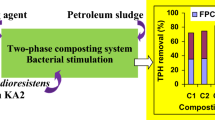Abstract
The effects of the C/N ratio, CaCO3 and PO4 addition, and temperature profile on reactor-based composting of weathered hydrocarbon-contaminated soil were evaluated in a series of 30-day tests in temperature-controlled mini-composters. Soil containing 17,000 mg (kg dry soil)−1 mineral oil and grease (MOG) was composted with maple leaves and alfalfa. Although the leaves and alfalfa also contained MOG, degradation of contaminated soil derived MOG (total MOG degradation minus MOG degradation in a control with no soil) increased from 0 to 45% as the quantity of co-substrate increased from 0 to 63%. Simulation of biopile conditions (i.e., aeration and addition of mineral salts but no co-substrate) resulted in only 6% MOG degradation. Addition of CaCO3 before composting increased total MOG degradation from 23% to 43%. Total MOG degradation increased with decreasing C/N ratio. At a molar C/N ratio of 17, 43% of the total MOG was degraded in 30 days, while at a C/N ratio of 40 there was no total MOG degradation. When temperatures ranging from 23 to 60 °C were investigated, 50 °C maintained for 29 days resulted in the maximum degradation which was 68% of total initial MOG.
Similar content being viewed by others
References
APHA, AWWA & WPCA (1985) In: Greenberg AE, Trussell RR, Clesceri LS & Franson MAH (Eds), Standard Methods for the Examination of Water and Wastewater, 16th edn, American Public Health Association, Washington, D.C
Beaudin N, Caron RF, Legros R, Ramsay J, Lawlor L & Ramsay B (1996) Composting of hydrocarbon contaminated soil in a laboratory-scale reactor. Compost Sc. & Util. 4: 37–45
Hogan JA, Tofoli GR, Miller FC, Hunder JV & Finstein MS (1988) Composting physical model demonstration: mass balance of hydrocarbons and PCB's, pp. 742–758. In: Wu XC (Ed), The International Conference on Physicochemical and Biological Detoxification of Hazardous Wastes, Vol. 2. Technomic Publication, Lancaster, PA
McGregor ST, Miller FC, Psarianos KM & Finstein MS (1981) Composting process control based on interaction between microbial heat output and temperature Appl. Environ. Microbiol. 41: 1321–1330
McKinley VL & Vestal JR (1984) Biokinetic analyses of adaptation and succession: Microbial activity in composting municipal sludge. Appl. Environ. Microbiol. 47: 933–941
Michel Jr, FC, Reddy A & Forney LJ (1993) Yard waste composting: Studies using different mixes of leaves and grass in a laboratory scale system. Comp. Sci. Util. 1: 85–96
Nakasaki, K., Yaguchi, H, Sasaki Y & Kubota H (1992) Effects of C/N ratio on thermophilic composting of garbage. J. Ferment. Bioeng. 73: 43–45
Rasiah V, Voroney RP & Kachanoski RG (1991) Effect of N amendment on C mineralization of an oily waste. Water Air Soil Pollut. 59: 249–259
Robertson L & Alexander M (1992) Influence of calcium, iron, and pH on phosphate availability for microbial mineralization of organic chemicals. Appl. Environ. Microbiol. 58: 38–41
Rosenbrock P, Martens P, Buscot F, Zadrazil F & Munch JC (1997) Enhancing the mineralization of (U-14) dibenzo-p-dioxin in three different soils by addition of organic substrates or inoculation with white-rot fungi. Appl. Microbiol. Biotechnol. 48: 665–670
Suler DJ & Finstein MS (1977) Effect of temperature, aeration, and moisture on CO2 formation in bench-scale, continuously thermophilic composting of solid waste. Appl. Environ. Microbiol. 33: 345–3–50
Valo R & Salkinoja-Salonen M (1986) Bioreclamation of chlorophenol-contaminated soil by composting. Appl. Microbiol. Biotechnol. 25: 68–75
Williams RT & Myler CA (1990) Bioremediation using composting. Biocycle 31: 78–82
Rights and permissions
About this article
Cite this article
Beaudin, N., Caron, R., Legros, R. et al. Identification of the key factors affecting composting of a weathered hydrocarbon-contaminated soil. Biodegradation 10, 127–133 (1999). https://doi.org/10.1023/A:1008365832031
Issue Date:
DOI: https://doi.org/10.1023/A:1008365832031




